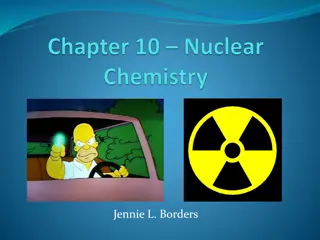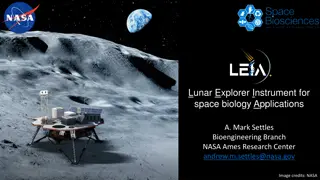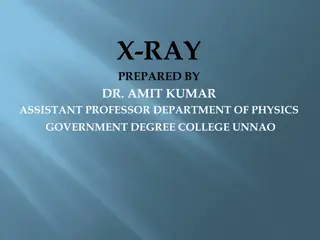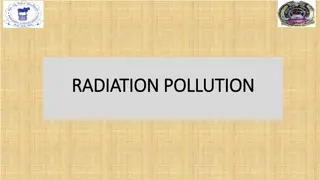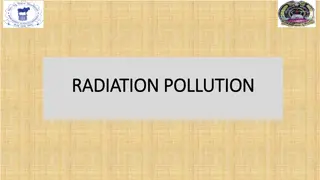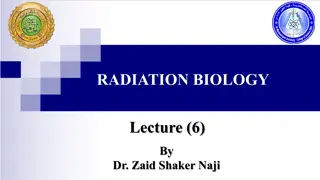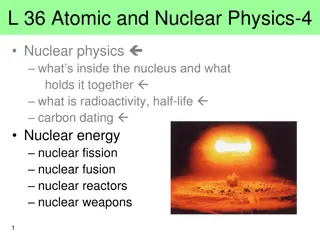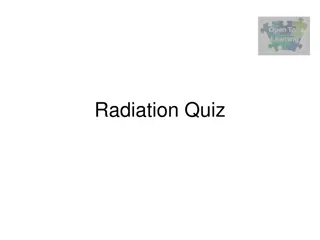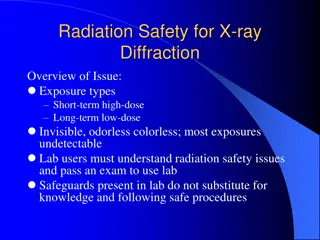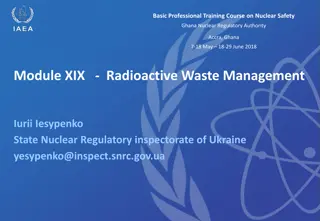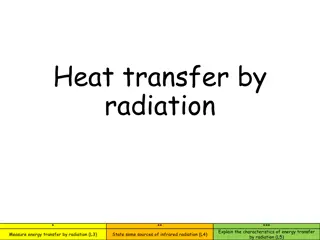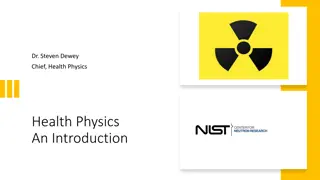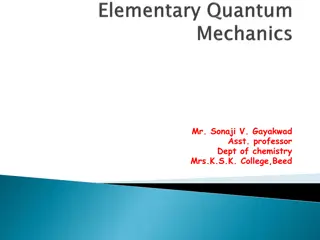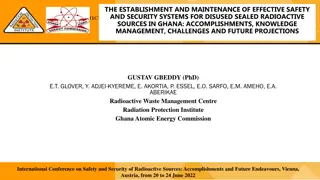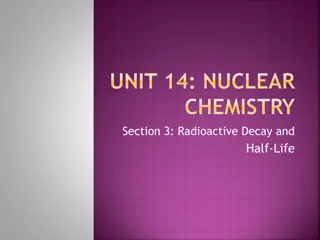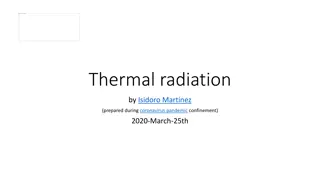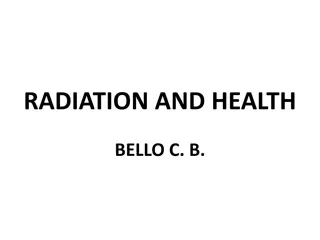Radiation Protection Training for Users of Sealed Radioactive Sources - May 2022
This document provides radiation protection training tailored for users of sealed radioactive sources, ensuring compliance with legislative requirements and university policies. The training covers topics such as ionising radiation, effects of exposure, monitoring requirements, and more. All training sessions, including refresher courses, must be officially documented. The definition of sealed sources and regulatory standards are also explained in detail.
Download Presentation

Please find below an Image/Link to download the presentation.
The content on the website is provided AS IS for your information and personal use only. It may not be sold, licensed, or shared on other websites without obtaining consent from the author.If you encounter any issues during the download, it is possible that the publisher has removed the file from their server.
You are allowed to download the files provided on this website for personal or commercial use, subject to the condition that they are used lawfully. All files are the property of their respective owners.
The content on the website is provided AS IS for your information and personal use only. It may not be sold, licensed, or shared on other websites without obtaining consent from the author.
E N D
Presentation Transcript
May 2022 Radiation Protection Training for Users of Sealed Radioactive Sources Tony Butterworth University Radiation Protection Adviser (RPA) University Radioactive Waste Adviser (RWA)
Radiation Protection Training for Users of Sealed Radioactive Sources May 2022 Introduction This document is designed to meet the training requirements of users of sealed sources of ionising radiation. Sealed source users do not usually work directly with unsealed ionising radiation, thus greatly reducing the potential for internal exposure.
Radiation Protection Training for Users of Sealed Radioactive Sources May 2022 Also, because of the nature of most sealed sources, the potential for external radiation exposure is greatly reduced. Sealed source users, like other users of ionising radiation, must receive training which meets legislative requirements and University policy.
Radiation Protection Training for Users of Sealed Radioactive Sources May 2022 The topics covered in this training will include: Introduction to ionising radiation (types, sources, properties) Effects of exposure to ionising radiation Monitoring, survey, security and posting requirements
Radiation Protection Training for Users of Sealed Radioactive Sources May 2022 All training (including further local training embracing risk assessment and standard operating procedures and refresher training) must be formally recorded using a suitable record of training form.
Radiation Protection Training for Users of Sealed Radioactive Sources May 2022 Definition of Sealed Source "Sealed Source" is a term used to describe radioactive sources which have been designed to prevent spread of radioactive material under normal working conditions.
Radiation Protection Training for Users of Sealed Radioactive Sources May 2022 The definition of a sealed source is given in Regulation 2 (1) of the Ionising Radiations Regulations 2017 (IRR17) A sealed source means a radioactive source whose structure is such as to prevent, under normal conditions of use, any dispersion of radioactive substances into the environment, but it does not include any radioactive substance inside a nuclear reactor or any nuclear fuel element .
Radiation Protection Training for Users of Sealed Radioactive Sources May 2022 The view from the Health & Safety Executive (HSE) is the term sealed source should only be applied either to sources where the source of ionising radiation is used directly as a source in work with ionising radiation, or where the indirect properties of the ionising radiation of the source are used. An example of the latter would be a thermoelectric generator, where the radioactive properties of a material generate heat which is used to produce electricity.
Radiation Protection Training for Users of Sealed Radioactive Sources May 2022 Examples of sealed sources include: Nickel-63 electron capture detector (Ni-63 ECD) - the radioactive isotope Ni-63 is electroplated to a metal foil. The foil is installed by the manufacturer in an inaccessible chamber inside the ECD cell.
Radiation Protection Training for Users of Sealed Radioactive Sources May 2022 Cesium-137 (Cs-137) or cobalt-60 (Co- 60) gamma sources. These usually contain a small, pea sized source which is sealed in a small welded capsule. The capsule is encased in a shield, usually lead, with a small shuttered opening which controls the gamma beam.
Radiation Protection Training for Users of Sealed Radioactive Sources May 2022 Types of Radiation The various types of radiation can be divided in to two categories: Non-ionising: examples of non-ionising radiation include visible light, heat, UV, radio waves Ionising: examples of ionising radiation include x-rays, gamma rays, and alpha and beta particles.
Radiation Protection Training for Users of Sealed Radioactive Sources May 2022 "Ionisation" is a process whereby a molecule is split into two or more parts called ions. The molecule could be as simple as a water molecule being split into H+ (hydrogen) and OH (hydroxide), or as complex as a long organic molecule such as DNA being split in to two new organic molecules. Ionising radiation is simply any radiation which can impart enough energy to cause ionisation of the target material.
Radiation Protection Training for Users of Sealed Radioactive Sources May 2022 The resulting ions produced by ionisation are electrically charged. These ions can go on to produce further chemical changes in the surrounding material, thus a single ionisation event could lead to a chain of chemical reactions. Ionising radiation is just one of many processes which can cause ionisation in matter. The human body is constantly repairing itself from natural processes which produce ionised molecules, such as natural metabolic processes, and molecular breakdown from the inherent instability of large organic molecules like DNA.
Radiation Protection Training for Users of Sealed Radioactive Sources May 2022 Sources of Ionising Radiation There are many sources of naturally occurring radioactive material, such as uranium and thorium in soil and rock, and carbon-14 in the atmosphere.
Radiation Protection Training for Users of Sealed Radioactive Sources May 2022 There are also artificially produced radioactive materials, such as nickel-63 in electron capture detectors, Cs-137, Am- 241/Be neutron sources, and many more. Regardless of whether the radioactive material is natural or artificial, these materials will continue to emit ionising radiation until all the material is depleted through the radioactive decay process. This can take thousands of years for an isotope such as Ni- 63 with a 100-year half-life.
Radiation Protection Training for Users of Sealed Radioactive Sources May 2022 In contrast to radioactive material, x-ray machines produce ionising radiation only when they are energised. When the machine is not energised, no ionising radiation is being produced, and thus no ionising radiation hazard exists. Unlike x-ray machines, with radioactive material there is always a risk from exposure to ionising radiation.
Radiation Protection Training for Users of Sealed Radioactive Sources May 2022 Properties of Radiation There is no sensory response to exposure from ionising radiation. Like radio waves, ionising radiation in normal intensities cannot be seen, felt, tasted or smelled. It can only be detected by radiation detectors, such as Geiger-Mueller counters, film badges and liquid scintillation counters (LSC s).
Radiation Protection Training for Users of Sealed Radioactive Sources May 2022 Ionising radiation can penetrate tissue. Its ability to penetrate depends on the type (e.g., gamma, x-ray, beta, neutron, alpha) and energy of radiation.
Radiation Protection Training for Users of Sealed Radioactive Sources May 2022 Each radioactive isotope has its own type and energy: Gamma radiation, such as that produced by Cs-137 and Co- 60, can easily penetrate tissue, glass, wood and even moderate amounts of metal. These radiation sources can pose both an external radiation risk if adequate shielding is not provided, and an internal radiation risk if the source leaks.
Radiation Protection Training for Users of Sealed Radioactive Sources May 2022 Beta radiation is easily shielded. The level of shielding depends on the energy of the beta radiation. The Ni-63 found in ECD s is easily shielded by even a sheet of paper because of its very low energy of emission. Thus this isotope has virtually no external radiation risk, though it certainly can be a dangerous source of internal exposure if the source is leaking.
Radiation Protection Training for Users of Sealed Radioactive Sources May 2022 Higher energy beta radiation, such as that produced by Phosphorus-32, requires thicker shielding, such as 10mm of plexiglass. P-32 is an example of a beta emitter which is both an external and internal radiation risk.
Radiation Protection Training for Users of Sealed Radioactive Sources May 2022 Activity Quantities of radioactive materials are measured in units called "Activity". Units of activity and common conversion factors are listed here: Becquerels (Bq) Curies (Ci) Disintegrations/minute (dpm)
Radiation Protection Training for Users of Sealed Radioactive Sources May 2022 1 Curie = 2.22x10+12dpm = 3.7x10+10dps 1 Curie = 3.7x10+10 Bq 1 Becquerel = 1 disintegration/second.
Radiation Protection Training for Users of Sealed Radioactive Sources May 2022 Half-life Radioactive material is constantly undergoing the process of radioactive decay, so the quantity of radioactive material (the activity) is constantly decreasing. Each isotope has its own rate of decay.
Radiation Protection Training for Users of Sealed Radioactive Sources May 2022 The half-life is the time it takes for one half of the material to be lost by radioactive decay.
Radiation Protection Training for Users of Sealed Radioactive Sources May 2022 For example, the isotope Ni-63 has a half-life of 100 years. So every 100 years 50% of Ni-63 will have decayed by ionising radiation to the non-radioactive element Copper- 63. It will take seven half-lives for a radioisotope to decay to less than 1% of its current activity
Radiation Protection Training for Users of Sealed Radioactive Sources May 2022 For example, in the case of Ni-63: 100yrs=50% decayed (50% remaining) 200yrs=75% decayed (25% remaining) 300yrs=87.5% decayed (12.5% remaining) 400yrs=93.75% decayed (6.25% remaining) 500yrs=96.875% decayed (3.125% remaining) 600yrs=98.4375% decayed (1.5625% remaining) 700yrs=99.21875% decayed (0.78125% remaining)
Radiation Protection Training for Users of Sealed Radioactive Sources May 2022 Types of Exposure External exposure occurs when all or part of the body is exposed to a penetrating radiation field from an external source. During exposure this radiation can be absorbed by the body or it can pass completely through. A similar thing occurs during an ordinary chest x-ray.
Radiation Protection Training for Users of Sealed Radioactive Sources May 2022 Note exposure to a radiation field does not cause an individual to become radioactive; the radiation exposure ceases as soon as the individual leaves the radiation field. All ionising radiation sources produce an ionising radiation field, but some fields are so small they pose no external radiation risk at all. Examples include low energy beta radiation emitters such as H-3, C-14, Ni-63, P-33 and S-35
Radiation Protection Training for Users of Sealed Radioactive Sources May 2022 Other sources of ionising radiation produce much higher energy ionising radiation fields, and care must be taken to shield the source and to monitor exposure while working around these sources. Examples include: Am-241 / Be neutron sources P-32 beta sources Cs-137 gamma sources Co-60 gamma sources X-ray machines (only when the machine is energised)
Radiation Protection Training for Users of Sealed Radioactive Sources May 2022 The other type of radiation injury involves contamination with radioactive materials. Contamination means radioactive materials in the form of gases, liquids, or solids are released into the environment and contaminate people externally (such as on the skin), internally (such as by ingestion), or both.
Radiation Protection Training for Users of Sealed Radioactive Sources May 2022 Contamination by radioactive material can lead to incorporation of radioactive material into the body. This can be the result of uptake of radioactive materials by body cells, tissues, and target organs such as bone, liver, thyroid, or kidney. In general, radioactive materials are distributed throughout the body based upon their chemical properties. Incorporation cannot occur unless contamination has occurred.
Radiation Protection Training for Users of Sealed Radioactive Sources May 2022 All radioisotopes are potentially hazardous if inhaled or ingested. This includes low energy isotopes such as H-3 and Ni-63. Frequent monitoring for contamination is necessary when working with any unsealed isotopes, and periodic leak tests are conducted for sealed sources (1-2 years).
Radiation Protection Training for Users of Sealed Radioactive Sources May 2022 X-ray machines contain no radioactive material, and thus pose no threat of contamination even when energised. When energised, an x-ray machine is a source of external radiation exposure.
Radiation Protection Training for Users of Sealed Radioactive Sources May 2022 Precautions (External / Internal Exposure) External Exposure The concept of time, distance and shielding is integral in maintaining radiation exposures as low as reasonably practicable (ALARP).
Radiation Protection Training for Users of Sealed Radioactive Sources May 2022 TIME Assuming "all things are equal", external radiation exposure (dose) is directly related to the duration of exposure. By reducing the time you are in a radiation field, you will correspondingly reduce your dose.
Radiation Protection Training for Users of Sealed Radioactive Sources May 2022 DISTANCE By maintaining as much distance as possible between you and a source of radiation, you can reduce your dose significantly. The relationship between radiation exposure and distance follows the inverse square law.
Radiation Protection Training for Users of Sealed Radioactive Sources May 2022 For example, if the dose rate at one metre from a radiation source is 1 mSvhr- 1, the dose rate at two metres is reduced to 0.25 mSvhr-1 (1/(2 squared) = 1/4).
Radiation Protection Training for Users of Sealed Radioactive Sources May 2022 SHIELDING By utilising appropriate shielding, radiation exposure can be reduced significantly. Appropriate shielding depends on the type of radiation. For example, Ni-63 has a weak beta, and requires no shielding, whereas Cs-137 emits gamma radiation and requires heavy shielding, such as lead or concrete blocks.
Radiation Protection Training for Users of Sealed Radioactive Sources May 2022 Internal Exposure For sealed sources, internal exposure is controlled by periodic leak tests. The general requirements for leak testing are covered in Regulation 28, IRR 17.
Radiation Protection Training for Users of Sealed Radioactive Sources May 2022 For most sealed sources, the leak test procedure is: Swab of exit port, shutter or storage container, which is sent to the RPA / RWA for analysis A source is considered to be leaking when the leak test shows greater than 200 Bq removable contamination (likely to be greater than x2 background count
Radiation Protection Training for Users of Sealed Radioactive Sources May 2022 Leak tests must be performed every year for sources which are outside of manufacturer s guarantee, otherwise every 2 years up to manufacturer s guarantee Records of leak tests must be maintained for at least two years after disposal of any sealed source.
Radiation Protection Training for Users of Sealed Radioactive Sources May 2022 Examples of Radiation Sources Unsealed Sources of Radioactive Material Unsealed radioactive material requires personal protective clothing (e.g., safety specs, lab coat and gloves).
Radiation Protection Training for Users of Sealed Radioactive Sources May 2022 While working with unsealed radioactive material, precautions must be made against the spread of contamination, such as constantly surveying while working with unsealed radioactive material, and use of disposable bench paper around the work area.
Radiation Protection Training for Users of Sealed Radioactive Sources May 2022 Equipment may become contaminated, such as pipettes, centrifuges, and glassware. There is usually a designated waste bin for radioactive waste. All unsealed radioactive material is a potential internal radiation hazard (e.g., it can be inhaled, ingested or absorbed through the skin, leading to dangerous exposure to internal organs).
Radiation Protection Training for Users of Sealed Radioactive Sources May 2022 Some isotopes also pose an external radiation hazard (e.g., P-32, Cs-137), and so shielding must be provided while working with this material to protect against exposure to the radiation field. Isotopes such as C-14 and H-3 emit such low energy beta radiation they can be safely handled without concern to external radiation exposure.
Radiation Protection Training for Users of Sealed Radioactive Sources May 2022 Sealed Sources of Radioactive Material Protective clothing and routine surveys are usually not required when working around sealed sources. There is very little chance material will leak under normal operating conditions, so the risk of contamination is very small, and there is very little risk of internal exposure, such as through ingestion of radioactive material.
Radiation Protection Training for Users of Sealed Radioactive Sources May 2022 However, any sealed source, regardless of which isotope is used, has the potential to be a hazard if it leaks, so each source should be regularly checked for leakage. External exposure to ionising radiation is possible with gamma and neutron emitting sources. If significant radiation levels are emitted from a source, operators are required to wear personal dosimeters, such as a film or thermo luminescent badge, to monitor exposure to the radiation field.
Radiation Protection Training for Users of Sealed Radioactive Sources May 2022 The Ni-63 sources inside an ECD cell produce such low energy beta radiation they have no external radiation risk, and in fact no radiation above natural background can even be detected outside an ECD cell.
Radiation Protection Training for Users of Sealed Radioactive Sources May 2022 X-Ray Machines X-ray machines only produce ionising radiation when they are energised. Appropriate warning lights indicate when the machine is in operation.


